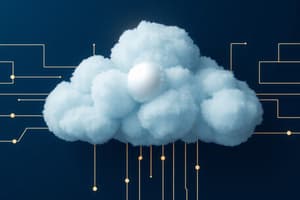Podcast
Questions and Answers
What is a primary advantage of cloud computing for businesses?
What is a primary advantage of cloud computing for businesses?
- Reduced efficiency in operations
- Reduced costs of new product launches (correct)
- Dependence on local servers
- Increased capital expenditure
Which statement accurately describes public cloud computing?
Which statement accurately describes public cloud computing?
- Shared hardware resources are accessed via the Internet. (correct)
- The infrastructure is privately managed by the organization.
- Data security is guaranteed by the cloud user organization.
- Users have exclusive access to resources and hardware.
What is a significant concern when utilizing public cloud services?
What is a significant concern when utilizing public cloud services?
- Data security and privacy (correct)
- Dependency on outdated technology
- High initial setup costs
- Limited access to corporate systems
Which of the following is NOT a type of cloud computing service?
Which of the following is NOT a type of cloud computing service?
How can employees benefit from cloud computing?
How can employees benefit from cloud computing?
What is a challenge organizations may face when using public cloud computing?
What is a challenge organizations may face when using public cloud computing?
What method does the operating system use to track where files are stored on a storage device?
What method does the operating system use to track where files are stored on a storage device?
Which operating systems are mentioned as not supporting real-time processing?
Which operating systems are mentioned as not supporting real-time processing?
What is the primary role of memory management in an operating system?
What is the primary role of memory management in an operating system?
Which user interface requires the memorization of text commands?
Which user interface requires the memorization of text commands?
What capability allows computers to send and receive data and share resources in a network?
What capability allows computers to send and receive data and share resources in a network?
How does the operating system ensure that each program gets the required memory without interference?
How does the operating system ensure that each program gets the required memory without interference?
Which operating system management method is used to increase processing efficiency?
Which operating system management method is used to increase processing efficiency?
What is a characteristic of a graphical user interface (GUI)?
What is a characteristic of a graphical user interface (GUI)?
What is a characteristic of Machine Learning (ML)?
What is a characteristic of Machine Learning (ML)?
In Supervised Learning, what is the main purpose of the training data?
In Supervised Learning, what is the main purpose of the training data?
Which of these is an example of how Machine Learning can be applied?
Which of these is an example of how Machine Learning can be applied?
What characterizes Generative Learning in the context of Machine Learning?
What characterizes Generative Learning in the context of Machine Learning?
What is the initial step in the Supervised Learning process?
What is the initial step in the Supervised Learning process?
How does Machine Learning typically differ from traditional programming?
How does Machine Learning typically differ from traditional programming?
What is the primary purpose of an Integrated Development Environment (IDE)?
What is the primary purpose of an Integrated Development Environment (IDE)?
Which of the following is NOT an example of an Integrated Development Environment (IDE)?
Which of the following is NOT an example of an Integrated Development Environment (IDE)?
Which IDE provides a simulator for testing applications intended for iOS devices?
Which IDE provides a simulator for testing applications intended for iOS devices?
What does an SDK primarily consist of?
What does an SDK primarily consist of?
Which of the following SDKs is specifically intended for developing Java-based web applications?
Which of the following SDKs is specifically intended for developing Java-based web applications?
Which of the following statements best describes version control integration in IDEs?
Which of the following statements best describes version control integration in IDEs?
What does Android Studio provide for testing applications?
What does Android Studio provide for testing applications?
Which Apple SDK is used for creating applications on watchOS?
Which Apple SDK is used for creating applications on watchOS?
Which feature is commonly provided by IDEs to assist in debugging code?
Which feature is commonly provided by IDEs to assist in debugging code?
What is one benefit of using an Integrated Development Environment?
What is one benefit of using an Integrated Development Environment?
Study Notes
Cloud Computing
- Cloud computing provides software and storage as an internet service, accessible with a web browser.
- Businesses benefit from cost savings in system design, installation, maintenance, and product/service launches, along with increased efficiency and remote access.
- Public cloud computing involves a service provider owning and managing infrastructure while organizations access shared hardware resources online.
- Data security is a significant concern in public cloud computing due to reliance on third-party safeguarding.
- Cloud computing services are categorized into three main types: Infrastructure as a Service (IaaS), Software as a Service (SaaS), and Platform as a Service (PaaS).
Operating Systems
- Operating systems utilize multitasking, multiprocessing, and multithreading to enhance processing efficiency.
- Not all operating systems support all task management approaches—for example, Windows, macOS, and general-purpose Linux lack support for real-time processing.
- File management involves the OS managing file and folder storage on devices using the “file system”, tracking file locations and access permissions.
- Memory management governs data storage in main memory by swapping data between RAM and disk, ensuring programs receive necessary memory without interference.
- Operating systems facilitate network communication, enabling data exchange and resource sharing among networked computers. Servers often have operating systems optimized for networking.
- User Interfaces (UIs) allow interaction with computer systems: command-line interfaces (CLI) require text commands, while graphical user interfaces (GUI) use icons and menus.
Integrated Development Environments (IDEs)
- IDEs offer an integrated package of tools essential for software engineering: code editors, compilers, debuggers, version control integration, and simulators/emulators for mobile app development.
- Common IDEs include Xcode, Visual Studio, and Eclipse.
- Mobile development IDEs provide simulators/emulators for virtual device testing, like Android Studio’s emulator and the Xcode Simulator for iOS.
Software Development Kits (SDKs)
- SDKs are collections of tools, libraries, and documentation that support application development for specific platforms.
- They are commonly offered by hardware, software, and cloud companies.
- Examples include Apple’s macOS SDK, iOS SDK, and watchOS SDK, as well as SDKs for Java: Android SDK, Apache Tomcat, AWS SDK for Java, Google Cloud SDK for Java, and Microsoft Azure SDK for Java.
Artificial Intelligence (AI)
- AI endeavors to automate tasks typically requiring human intelligence, encompassing fields like robotics, natural language processing, and computer vision.
- Machine Learning (ML) is a subset of AI that enables computers to learn from data without explicit programming.
- ML relies on data and algorithms, where data serves as the foundation for learning, and algorithms provide the structure for machine learning.
- ML encompasses various types, including supervised learning and generative learning (Generative AI).
Supervised Learning
- Supervised learning is a type of ML where the model is trained on labeled data.
- The goal is to learn a mapping from input to output.
- The process involves training data with input-output pairs, model training to predict output based on input, and prediction for new inputs.
- Applications include image classification and predicting house prices based on features.
Supervised Learning: Applications
- Supervised learning has numerous applications:
- Spam detection
- Medical diagnosis
- Fraud detection
- Financial forecasting
Supervised Learning: Example of Training Data
- Training data in supervised learning consists of input-output pairs, e.g., images paired with their corresponding categories.
Supervised Learning: Acquiring Data
- Data for supervised learning can be obtained through manual labeling, observing user behavior, or downloading from online sources like Hugging Face Datasets and Kaggle.
Summary
- The OS is crucial to computer operations, handling data input, processing tasks, and displaying results.
- Organizations rely on off-the-shelf software for common needs and develop custom software for specific requirements.
- Cloud computing has revolutionized software development by offering scalability, flexibility, and global access, facilitating innovation and adaptability.
- Machine learning extends software development by integrating adaptive, data-driven models into traditional rule-based systems, enabling learning and evolution over time.
Studying That Suits You
Use AI to generate personalized quizzes and flashcards to suit your learning preferences.
Related Documents
Description
Test your knowledge on cloud computing and operating systems in this comprehensive quiz. Explore topics like IaaS, SaaS, PaaS, and the functionalities of various operating systems. Understand the benefits and challenges of cloud services and task management techniques.




